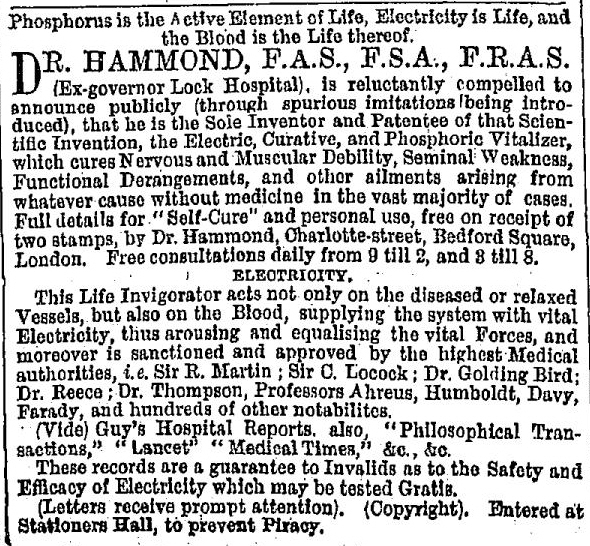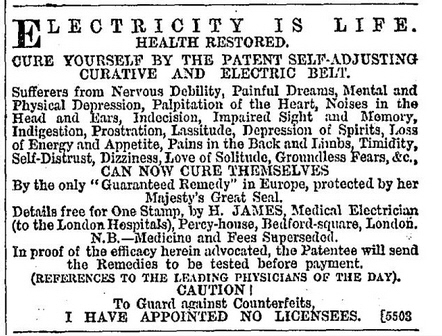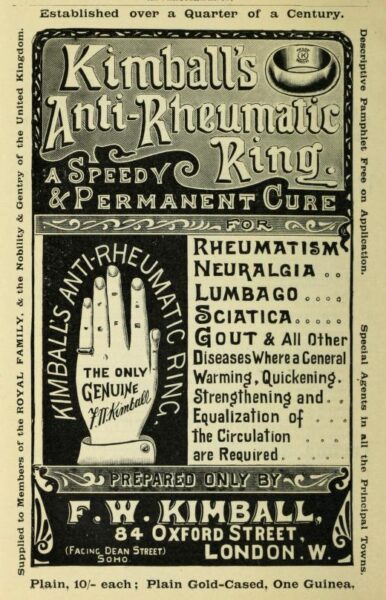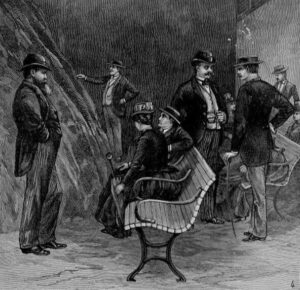Source: The North Wales Chronicle 18 April 1868
In a series of letters to the Medical Circular in the 1860s, Francis Burdett Courtenay, under the pseudonym ‘Detector’, exposed the villainous practices of a breed of quacks preying on men who suspected they had spermatorrhea.
Spermatorrhea (an excessive discharge of semen) was a source of such panic in the mid-19th century that there were even cases of suicide among those who had convinced themselves – or been led to believe – that they were suffering.
In one of the letters (which he collected into a pamphlet called Revelations of Quacks and Quackery in 1865) Courtenay cites the case of an anxious young man who responded to one of Dr Hammond’s advertisements. The reply asked for two guineas for a ‘self-curative’ belt – he sent the money, but the package he received in return contained only ‘some bottles of medicine and a lotion to rub over the penis and testicles.’ Annoyed that he didn’t get the belt, the patient wrote back, asking where it was.
Hammond responded with a missive calculated to scare his patient half to death. He had looked further into the case (even though he had never actually seen the man) and decided ‘a slight disease of the kidneys’, was causing semen to drain away.
This vital waste is not only capable of causing all the symptoms you detail, but such is the sympathy existing between the generative functions and the brain, that should this drain of the most vital of all your secretions be not immediately arrested, your whole system must suffer very serious derangement, whilst the organs of generation themselves will become vitiated and relapse into a state of utter impotency.
This would result in complete loss of erectile function and lead to ‘withering and wasting of the penis’. In case the lad wasn’t already terrified enough, Hammond predicted that his case would end in insanity. Fortunately, he had sought help just in time!
Hammond again recommended the curative belt (which the patient thought he’d already paid for) and sent a bill for a further 2 guineas. The young man paid up, and while it would be easy to laugh at him throwing good money after bad, there’s no law against being inexperienced and scared that there’s something seriously wrong with you.
The belt arrived, and proved to be an ordinary suspensory bandage, with a band that went round the patient’s waist, holding up a circular string of metal pieces through which one had to place the part in question. This would somehow provide
a continuous current of electricity, which is taken up by the whole system, infusing new life and ‘manly vigour’ into the debilitated or relaxed frame, and affords great support and comfort to the testicles and generative organs.
The patient subsequently consulted Courtenay and was reassured that there was nothing wrong with him.
As well as the belts, Hammond sold ‘Restorative Powders’ and ‘Seminal Replenisher’, which were not only supposed to produce top-quality semen, but also restore ‘brain fluid’, whatever that might be.
In 1869, the more famous electric belt manufacturer, Pulvermacher, tried to gain an injunction against Hammond for using the trademarked slogan ‘Electricity is Life’ – and for bringing the whole electric belt business into disrepute – but failed as it proved difficult to find out exactly who Hammond was.
The following advert, placed right underneath a Dr Hammond ad in the Bristol Mercury, appears to promote a competing specialist in electrical medicine. Percy House and 11 Charlotte Street were, however, the same place, and Henry James was either a sidekick of Hammond’s or quite possibly the same guy. Further aliases later joined the team – there were Dr Walter Jenner, Dr Harrison, Mr Raphey and Mr A Barrows, all at slightly different versions of the same address. Once patients gave up on the useless treatment from one alias, they would receive through the post a pamphlet extolling the superior virtues of another.
Hammond also employed what Courtenay referred to as ‘the hospital dodge’. His earlier ads proclaimed him to be ‘of the Lock Hospital’ and his letterhead described him as ‘F.A.S., F.S.A., M.R.A.S., H.G. St Mary’s, King’s College, The Lock, and St George’s Hospitals, LONDON.’ An impressive list – but F.A.S., F.S.A. and M.R.A.S. didn’t stand for any recognised qualifications, and H.G. simply meant ‘Honorary Governor.’
Any Tom, Dick or Harry could become an honorary governor just by making a charitable subscription to the hospital. Although the Lock cancelled Hammond’s donations when they found out what he was up to, this didn’t stop him continuing to deceive patients by claiming affiliation with these respectable institutions.





Caroline,
Either you had great fun writing this, or you were in a good mood to start with.
This post is delightful evidence that it is not just young women who are neurotic enough to suffer from imaginary illnesses.
Dr Hammond actually doing it best in inventing the Electric, Curative & Phosphoric Vitalizer. He is really a genius. Thank you for sharing this post.